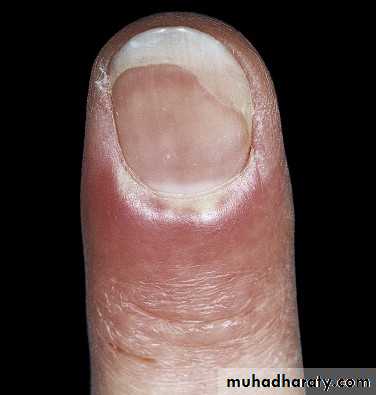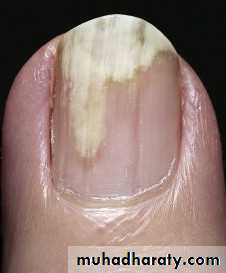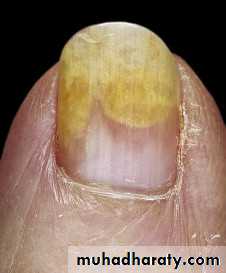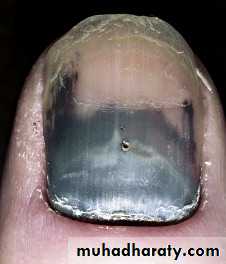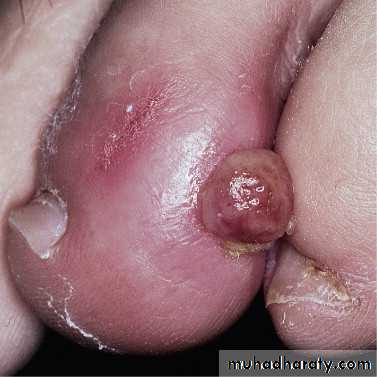Nail DiseasesNAIL DISORDERS ASSOCIATED WITH SKIN DISEASE
Psoriasis:1.Subungual hyperkerstosis
2.Onycholysis
3.Pitting
4.Oil spot sign
5.Total dystrophy
Rx: Nail psoriasis is difficult to treat. Relapse is common. Systemic agents such as cyclosporine, methotrexate, acitretin, or biologics may help. Also intralesional triamcinolone acetonide, calcipotriol and tazarotene.
PUSTULAR PSORIASIS OF THE NAIL APPARATUS:
Pustular psoriasis of the nail bed, matrix, or surrounding skin is common and may be painful, has a chronic course and poor response to treatment.
Severe cases are treated with systemic retinoids; dovobet and topical calcipotriol are also effective.
LICHEN PLANUS:
Approximately 25% of patients with nail lichen planus (LP) have LP in other sites before or after the onset of nail lesions.Description: Longitudinal grooving and ridging are the most common findings of LP of the nail.
A pterygium, caused by adhesion of a depressed proximal nail fold to the scarred matrix, may occur after intense matrix inflammation.
The nail plate distal to this focus is either absent or thinned out.
Treatment:In most cases, nail LP is self-limiting or promptly regresses with treatment. Matrix lesions may respond to intralesional triamcinolone acetonide. Severe cases respond to prednisolone
ACQUIRED NAIL DISORDERS
Bacterial and viral infections:ACUTE PARONYCHIA: The rapid onset of painful, bright red swelling of the proximal and lateral nailfold may occur spontaneously or may follow trauma or manipulation. Infections present with an accumulation of purulent material behind the cuticle .
Rx …drainage of pus and a.b
CHRONIC PARONYCHIA {discussed previously}
PSEUDOMONAS INFECTION: Repeated exposure to soap and water causes maceration of the hyponychium and softening of the nail plate. Separation of the nail plate (onycholysis) exposes a damp, macerated space between the nail plate and the nail bed, which is a fertile site for the growth of Pseudomonas.The nail plate assumes a green-black color. There is little discomfort or inflammation.
DDx? and Rx:anti pseudomonal a.b (ciprofloxacine)
HERPETIC WHITLOW : In the past, dentists and nurses were at risk of acquiring herpes simplex virus (HSV) infection of the fingertip. The risk has greatly diminished with the use of gloves.
Young adults are typically affected by HSV-2. HSV-1 infection of the hand occurs in children as a result of autoinoculation following herpetic gingivostomatitis.
cl.f: There is extreme pain from the swollen fingertips, Lymphangitis and lymphadenitis, secondary to HSV infection of the hand, are possible complications, particularly with HSV-2 infection.
Herpetic finger infections in AIDS patients may rapidly progress to the complete destruction of nail structures.
DRUG-INDUCED PARONYCHIA : The protease inhibitors lamivudine and indinavir can cause paronychia and ingrown toe nails in about 4% of patients.
Fungal nail infections {Discussed previously}
Trauma:
1.ONYCHOLYSIS
Onycholysis : the painless separation of the nail from the nail bed, is common.
Begins at the distal groove and progresses irregularly and proximally, causing part or most of the plate to become separated.
The non adherent portion of the nail is opaque with a white, yellow or green tinge.
Causes of onycholysis include : psoriasis, trauma, Candida or Pseudomonas infections, internal drugs, PUVA photochemotherapy, contact with chemicals, maceration from prolonged immersion, allergic contact dermatitis, and hyperthyroidism .Onycholysis is most frequently seen in women with long fingernails. Forcing a stylus between the nail plate and bed while manicuring can cause separation.
Rx: Remove separated nail, promote dryness, avoid manipulation and irritants, miconazole and fluconazole.
2.NAIL AND CUTICLE BITING
Nail biting: is a nervous habit that usually begins in childhood and lasts for years. One or all nails may be chewed as far as the lunula. Thin strips of skin on the lateral and proximal nai lfold may also be stripped. Patients are aware of their habit but seem powerless to control it.Prevention: Mild aversion such as painting the nail plate with a distasteful preparation resulted in significant improvements in nail length.
3.HANGNAIL
Triangular strips of skin may separate from the lateral nailfolds, particularly during the winter months. An attempts at removal may cause pain and extension of the tear into the dermis.
Rx: Separated skin should be cut before extension occurs. Constant lubrication of the fingertips with skin creams and avoidance of repeated hand immersion in water are beneficial.
3.INGROWN TOENAIL
Ingrown fingernails and toenails are common.The large toe is the most frequently affected.
The nail pierces the lateral nailfold and enters the dermis, where it acts as a foreign body.The first signs are pain and swelling.
The area of penetration becomes purulent and edematous as exuberant granulation tissue grows alongside the penetrating nail.
Ingrown nails are caused by lateral pressure of poorly fitting shoes, improper or excessive trimming of the lateral nail plate, or trauma.
Prevention: horizontal cutting of nail(not short,round,v shape)
treatment: nail removal partialy or completely(surgical apulsion)
4.SUBUNGUAL HEMATOMA
Subungual hematoma may be caused by trauma to the nail plate, which causes immediate bleeding and pain.The quantity of blood may be sufficient to cause separation and loss of the nail plate.RX:The traditional method of puncturing the nail with a red-hot paperclip tip remains the quickest and most effective method of draining the blood.
Trauma to the proximal nailfold causes hemorrhage that may not be apparent for days and then grows with the nail.
Young children with subungual hematoma may be victims of child abuse.
5.DISTAL PLATE SPLITTING (BRITTLE NAILS)
The splitting into layers or peeling of the distal nail plate may resemble or be analogous to the scaling of dry skin. This nail change is found in approximately 20% of the adult population.Repeated water immersion and the frequent use of nail polish removers increase the incidence of brittle nails, particularly in women. Rx: Protection and moisturizationTHE NAIL AND INTERNAL DISEASE
YELLOW NAIL SYNDROME(مهم) :Yellow nail syndrome is a rare acquired condition defined by the presence of yellow nails. It is associated with lymphedema and/or chronic respiratory manifestations (pleural effusions, bronchiectasis, chronic sinusitis, and recurrent pneumonias). Patients note that nail growth slows and appears to stop.The nail plate may become excessively curved, and it turns dark yellow. The surface remains smooth or acquires transverse ridges. Onycholysis may occur. The cuticles and lunulae are lost, and usually all the nails are involved.
RX: Oral vitamin E in dosages of up to 800 IU/day for up to 18 months may help. The condition improves in about half of patients, often without specific therapy.
Tumors
PYOGENIC GRANULOMAAlso called “lobular capillary hemangioma“
May form at the lateral nailfold caused by an ingrown nail.
A pedunculated nodule with a smooth, glistening surface. The surface frequently becomes crusted, eroded, or ulcerated. Minor trauma may produce considerable bleeding.
This benign mass of vascular tissue is removed with thorough electrodesiccation and curettage.
Recurrences are common if any residual tissue is left.




